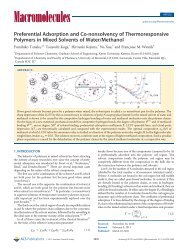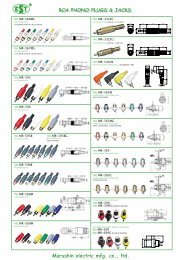Create successful ePaper yourself
Turn your PDF publications into a flip-book with our unique Google optimized e-Paper software.
2 S. GINDIKIN AND T. MATSUKILet {S j | j ∈ J} be the set of K C -B double cosets in G C of codimension one andT j = Sjcl denote the closure of S j . The sets T j will play an important role in ourconstructions.The compliment of S 0 in G C is written as∪j∈J(by Theorem 2 in Section 2). So the set C(S 0 ) is the compliment of the infinitefamily of complex hypersurfacesT jT −1j g (j ∈ J, g ∈ S ′ 0)and hence the connected component C(S 0 ) 0 is Stein.This domain is sometimes called the “Iwasawa domain” since it is a maximaldomain where all Iwasawa decompositions can be holomorphically extended fromG R .In [GM], we definedC = ∩ C(S)where we take the intersection for all K C -orbits on X on all flag manifolds X = G C /Pof G C and conjecturedC = ˜D 0 Z(Conjecture 1.3) where D 0 = ˜D 0 /K C is the domain introduced by [AG] (which issometimes denoted as Ω AG ) and Z is the center of G C . For connected components,it means(B)C 0 = ˜D 0 .It is proved in Proposition 8.3 of [GM] thatC 0 = C(S 0 ) 0 .In other words, C(S) 0 is minimal when S = S 0 . We believe that it is one of centralfacts of this theory since it gives a very strong estimate of all C(S) through C(S 0 )only. So the conjecture (B) is equivalent toC(S 0 ) 0 = ˜D 0 .Recently, the inclusion C(S 0 ) 0 ⊂ ˜D 0 is proved by Barchini ([B]). On the other hand,the opposite inclusion C(S 0 ) 0 ⊃ ˜D 0 is proved for all classical cases ([GM], [KS]) andexceptional Hermitian cases ([GM]). It is announced that it is proved for all spacesin [H]. (We had no chance to see this preprint.)Remark 1. In [FH], the authors deduce the inclusion C 0 ⊂ ˜D 0 from their resultabout C(S) for closed S and Proposition 8.1 in [GM]. As we showed above, thisinclusion is already the consequence of Proposition 8.3 in [GM] and [B]. So it doesnot need the results in [FH].
A REMARK ON SCHUBERT CELLS AND DUALITY OF ORBITS ON FLAG MANIFOLDS 32. Schubert cells in the category of K C -B double cosetsThe principal idea of our considerations in [GM] was that C(S) 0 will be essentiallyindependent of neither S nor the flag manifold X = G C /P . To justify it, we needto build bridges between C(S) for different S and for it we need to see connectionsbetween different K C -orbits. It turns out that Schubert cells are very efficient tool forsuch considerations as in Section 2 and Section 8 in [GM]. They give a possibilityto obtain an important information about general C(S) from a consideration ofsimplest S. Here we refine connections between K C -orbits and Schubert cells andgive more examples of applications.For a simple root α in the root system with respect to the order defined by B, wecan define a parabolic subgroupof G C such that dim C P α = dim C B + 1.P α = B ∪ Bw α BLemma 1. Let S 1 be a K C -B double coset. Then we have:(i) If dim C S 1 P α = dim C S 1 , then S1 cl P α = S1 cl .(ii) If dim C S 1 P α = dim C S 1 + 1, then there exists a K C -B double coset S 2 suchthat S1 cl P α = S cl2 .Proof. Though this lemma follows easily from [M2] Lemma 3, we will give a prooffor the sake of completeness. Write S 1 = K C gB. Then we have a natural bijection(g −1 K C g ∩ P α )\P α /B ∼ = K C \K C gP α /B = K C \S 1 P α /Bby the map x ↦→ gx.(i) If dim C S 1 P α = dim C S 1 , then (g −1 K C g ∩ P α )B/B is Zariski open in P α /B =P 1 (C) and hence it is dense. So we haveS cl1 = (K C gB) cl ⊃ S 1 P α ⊃ S 1and therefore S1 cl = S1 cl P α .(ii) Suppose dim C S 1 P α = dim C S 1 + 1. Then there exists a p ∈ P α such that(g −1 K C g ∩ P α )pB/B is Zariski open in P α /B = P 1 (C) since the number of K C -Bdouble cosets in G C is finite. If we write S 2 = K C gpB, then we have(S 2 ) cl ⊃ S 1 P α ⊃ S 2and therefore S cl2 = S cl1 P α . q.e.d.Theorem 1. Let S 1 be a K C -B double coset in G C and w an element of W . Thenwe have:(i) S1 cl (BwB) cl = S2 cl for some K C -B double coset S 2 .(ii) (minimal expression) There exists a w ′ ∈ W such that w ′ < w (Bruhat order),l(w ′ ) = dim C S 2 − dim C S 1 and thatS cl1 (Bw ′ B) cl = S cl2 .Here l(w ′ ) = dim C Bw ′ B − dim C B is the length of w ′ .
4 S. GINDIKIN AND T. MATSUKIProof. (i)written asThis follows from Lemma 1 because every Schubert cell (BwB) cl is(BwB) cl = P α1 · · · P αlwhere w = w α1 · · · w αl is a minimal expression of w ∈ W .(ii) By Lemma 1, we can choose a subsequence β 1 , . . . , β q (q = dim C S 2 −dim C S 1 )of α 1 , . . . , α l such thatfor k = 1, . . . , q and thatdim C S cl1 P β1 · · · P βk = dim C S cl1 P β1 · · · P βk−1 + 1S cl2 = S cl1 (BwB) cl = S cl1 P α1 · · · P αl = S cl1 P β1 · · · P βq = S cl1 (Bw ′ B) clwith w ′ = w β1 · · · w βq .q.e.d.Remark 2. S1 cl (BwB) cl = S2 cl implies S1 cl ⊂ S2 cl . But S1 cl ⊂ S2 cl does not alwaysimply S1 cl (BwB) cl = S2 cl for some w (c.f. [M2]).Definition 1. For every K C -B double coset S, we can define, by Theorem 1, asubset J(S) of J byJ(S) = {j ∈ J | S cl (BwB) cl = T j for some w ∈ W }.Lemma 2. Let S be a non-open K C -B double coset. Then there exists a simpleroot α such thatdim C SP α = dim C S + 1.Proof. Write G C = (Bw 0 B) cl = P α1 · · · P αmdim C SP α = dim C Sfor all simple roots α, then we have, by Lemma 1,a contradiction.Theorem 2.for some j ∈ J(S).G C = S cl G C = S cl P α1 · · · P αm = S cl ,If l(w) < codim C S, thenS cl (BwB) cl ⊂ T jwith the longest element w 0 in W . Ifq.e.d.Proof. Since codim C S cl (BwB) cl = d > 0, we can choose simple roots α 1 , . . . , α d−1such thatcodim C S cl (BwB) cl P α1 · · · P αd−1 = 1by Lemma 2. Since (BwB) cl P α1 · · · P αd−1 = (Bw ′ B) cl for some w ′ ∈ W , we haveS cl (BwB) cl ⊂ S cl (Bw ′ B) cl = T jfor some j ∈ J(S).q.e.d.
A REMARK ON SCHUBERT CELLS AND DUALITY OF ORBITS ON FLAG MANIFOLDS 5Definition 2.3. ApplicationsFor every subset J ′ in J, we define a domain Ω(J ′ ) in G C byΩ(J ′ ) = {x ∈ G C | xT j ∩ S ′ 0 = ϕ for all j ∈ J ′ } 0 .We can prove the following corollary:Corollary Let S be a closed K C -P double coset in G C . Write S = S1 cl with thedense K C -B double coset S 1 in S. Then we haveC(S) 0 = Ω(J(S 1 )).Remark 3. (i) We can see C(S 0 ) 0 = Ω(J). By the same argument as for C(S 0 ) 0in Section 1, we can prove Ω(J ′ ) is Stein for every subset J ′ in J. So the Steinness ofC(S) 0 ([W]) becomes a corollary of this equivalence C(S) 0 = Ω(J(S 1 )) (c.f. [HW]).(ii) It is clear that Ω(J ′ ) ⊃ Ω(J) for every subset J ′ in J. So we haveC(S) 0 ⊃ C(S 0 ) 0 .But this inclusion was already proved in Proposition 8.3 in [GM]. This is naturalbecause the way of proof of the corollary below is essentially the same as that ofProposition 8.3 in [GM]. So the above corollary may be considered as its refinement.Proof of Corollary. Let x be an element on the boundary of C(S) 0 . ThenxS ∩ S ′ 2P ≠ ϕfor some G R -P double coset S ′ 2P in the boundary of S ′ . Here we take S 2 as thedense K C -B double coset contained in S 2 P . Since S is right P -invariant, we havexS ∩ S ′ 2 ≠ ϕ and dim C S 2 > dim C S.Applying Theorem 1 (ii) to the pair (S cl2 , G C ), we can take a w ∈ W such thatl(w) = codim C S 2 and thatS 2 (BwB) cl = G C .So we have S 2 (BwB) cl ⊃ S 0 and henceSince xS ∩ S ′ 2 ≠ ϕ, we haveS ′ 2 ⊂ S ′ 0(Bw −1 B) cl .xS ∩ S ′ 0(Bw −1 B) cl ≠ ϕ.HencexS(BwB) cl ∩ S 0 ′ ≠ ϕwhich implies xT j ∩ S 0 ′ ≠ ϕ for some j ∈ J(S 1 ) by Theorem 2. Thus x /∈ Ω(J(S 1 )).Conversely, supposexT j ∩ S 0 ′ ≠ ϕfor some T j = S(BwB) cl = S1 cl (BwB) cl . Note that j ∈ J(S 1 ) by Definition 1 andthat we may assume l(w) = codim C S − 1 = codim C S 1 − 1 by Theorem 1 (ii). Thenwe havexS ∩ S 0(Bw ′ −1 B) cl ≠ ϕ
6 S. GINDIKIN AND T. MATSUKIand hencexS ∩ S ′ 3 ≠ ϕfor some K C -B double coset S 3 such that S ′ 3 ⊂ S ′ 0(Bw −1 B) cl . Hence S 3 (BwB) cl ⊃ S 0and therefore dim C S 3 ≥ dim C G C − l(w) > dim C S. So we haveS ′ 3 ∩ S ′ = ϕbecause S ′ is the union of G R -B double cosets S ′ 4 satisfying S 4 ⊂ S. Hence we haveand thereforeRemark 4.xS ⊄ S ′x /∈ C(S).q.e.d.(i) The condition l(w) = codim C S − 1 does “not always” implycodim C S cl (BwB) cl = 1.Counter examples exist already for G R = SU(2, 1).(ii) The construction of the domain Ω(J(S 1 )) is essentially equivalent to theconstruction of “Schubert domain” in [HW]. Unfortunately, their basic definitionneeds a correction and after this correction their proof of Corollary 3.2 correspondingto our Corollary is not complete. We can see that the proof of Corollary using theresults in Section 2 is extremely simple. Let us explain the connection between thesetwo constructions introducing notations in [HW].Take a Borel subgroup B 0 of G C so that G R B 0 is closed in G C . A Borel subgroupB of G C is called an “Iwasawa Borel subgroup” ifB = g 0 B 0 g −10 for some g 0 ∈ G R .Let Z = G C /Q be a flag manifold. Then we can take Q so that Q ⊃ B 0 . EverySchubert cell Y in Z for B is written asY = (Bg 0 wQ) cl = (g 0 B 0 wQ) clwith some w ∈ W . Let C 0 be a closed K C -Q double coset (do not miss with C 0 ofSection 1!). The “incidence divisor” H Y is written asH Y = {g | gC 0 ∩ Y ≠ ϕ} = Y C −10 = (g 0 B 0 wQ) cl C −10 = (C 0 (Qw −1 B) cl g −10 ) −1 .In this point, in [HW], it is written: “If codim Y ≤ dim C 0 + 1, then H Yhypersurface in G C .” It is wrong as we remarked in (i).But if codim H Y = 1, thenH −1Y= C 0 (Qw −1 B 0 ) cl g0 −1 = T j g0−1for some j ∈ J ′ = J(C 1 ) (where C 1 is the dense K C -B 0 double coset in C 0 ) andg 0 ∈ G R by our notation.So their definition of y(D) should be corrected toy(D) = {Y = (g 0 B 0 wQ) cl | codim H Y = 1}.is a
A REMARK ON SCHUBERT CELLS AND DUALITY OF ORBITS ON FLAG MANIFOLDS 7Here D is the G R -orbit dual to C 0 . (The condition Y ⊂ Z \ D follows fromcodim H Y = 1 becauseY ∩ D = ϕ ⇐⇒ DY −1 = D(Qw −1 B 0 ) cl g −10 ∌ e⇐⇒ D(Qw −1 B 0 ) cl ∌ g 0⇐⇒ D(Qw −1 B 0 ) cl ∩ G R B 0 = ϕ⇐⇒ C 0 (Qw −1 B 0 ) cl ∩ K C B 0 = ϕ⇐⇒ codim C 0 (Qw −1 B 0 ) cl ≥ 1.)The Schubert domain is defined as⎧ ⎛⎨Ω S (D) =⎩ G C \ ⎝ ∪Y ∈y(D)⎞⎫⎬H Y⎠This definition is equivalent to ours becauseg /∈∪H Y ⇐⇒ g −1 /∈ T j g0 −1 for all j ∈ J ′ and g 0 ∈ G RY ∈y(D)⎭0⇐⇒ g −1 G R B 0 ∩ T j = ϕ for all j ∈ J ′⇐⇒ G R B 0 ∩ gT j = ϕ for all j ∈ J ′ .(iii) So in their Corollary 3.2 in [HW], (2) codim Z (Y ) = q + 1 does not imply(3) H Y is a hypersurface in Ω. Thus the proof of Corollary 3.2 is incomplete.Remark 5. The problem of the description of the domain of cycles C(S) 0 for groupsG R of Hermitian type is simpler than the general case. Firstly, in this case, D 0 =˜D 0 /K C has a very simple description: D 0∼ = GR /K × G R /K (Proposition 2.2 in[GM]). As usual, the equality C(S) 0 = ˜D 0 for S (↔ S ′ ) of nonholomorphic typeis reduced to two inclusions. The proof of C(S) 0 ⊂ ˜D 0 in [WZ1] had a mistakewhich was corrected in [WZ2]. The opposite inclusion was checked in [WZ1] forclassical Hermitian groups. In Proposition 2.4 of [GM], we gave a very simple proofof this inclusion for arbitrary groups of Hermitian type which is free of case-by-caseconsiderations: the use of Schubert cells makes this fact almost trivial. The note[WZ2] also contains this fact with a proof referred to [HW] (which is incomplete asis explained in Remark 4) but without an appropriate reference on the precedingproof in [GM]. Moreover it asserts a misleading statement that the preprint [GM]does not contain a direct proof..[AG][B][FH]ReferencesD. N. Akhiezer and S. G. Gindikin. On Stein extensions of real symmetric spaces. Math.Ann., 286:1–12, 1990.L. Barchini. Stein extensions of real symmetric spaces and the geometry of the flag manifold.preprintG. Fels and A. Huckleberry. Characterization of cycle domains via Kobayashi hyperbolicity.preprint (AG/0204341)
8 S. GINDIKIN AND T. MATSUKI[GM] S. Gindikin and T. Matsuki. Stein extensions of Riemann symmetric spaces and dualitiesof orbits on flag manifolds. preprint (MSRI-Preprint 2001-028)[H] A. Huckleberry. On certain domains in cycle spaces of flag manifolds. to appear in Math.Annalen[HW] A. Huckleberry and J. A. Wolf. Schubert varieties and cycle spaces. preprint (AG/0204033)[KS] B. Krötz and R. Stanton. Holomorphic extension of a representations: (I) automorphicfunctions. preprint[M1] T. Matsuki. Orbits on affine symmetric spaces under the action of parabolic subgroups.Hiroshima Math. J., 12:307–320, 1982.[M2] T. Matsuki. Closure relations for orbits on affine symmetric spaces under the action ofminimal parabolic subgroups. Adv. Studies in Pure Math., 14:541–559, 1988.[M3] T. Matsuki. Closure relations for orbits on affine symmetric spaces under the action ofparabolic subgroups. Intersections of associated orbits. Hiroshima Math. J., 18:59–67, 1988.[Sp] T. A. Springer. Some results on algebraic groups with involutions. Adv. Studies in PureMath., 6:525–534, 1984.[WW] R. O. Wells and J. A. Wolf. Poincaré series and automorphic cohomology on flag domains.Annals of Math., 105:397–448, 1977.[W] J. A. Wolf. The Stein condition for cycle spaces of open orbits on complex flag manifolds.Annals of Math., 136:541–555, 1992.[WZ1] J. A. Wolf and R. Zierau. Linear cycle spaces in flag domains. Math. Ann., 316:529–545,2000.[WZ2] J. A. Wolf and R. Zierau. A note on the linear cycle spaces for groups of Hermitian type.to appear in J. of Lie Theory.Simon Gindikin, Department of Mathematics, Hill Center, Rutgers University, 110Frelinghysen Road, Piscataway, NJ 08854-8019, U.S.A.E-mail address: gindikin@math.rutgers.eduToshihiko Matsuki, Faculty of Integrated Human Studies, Kyoto University, Kyoto606-8501, JapanE-mail address: matsuki@math.h.kyoto-u.ac.jp












